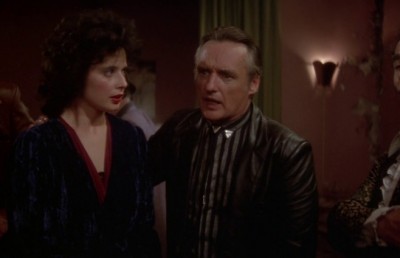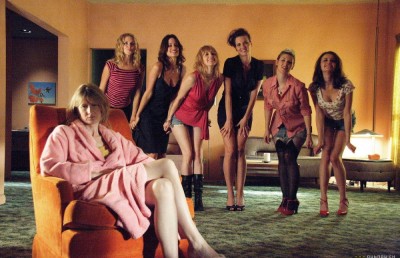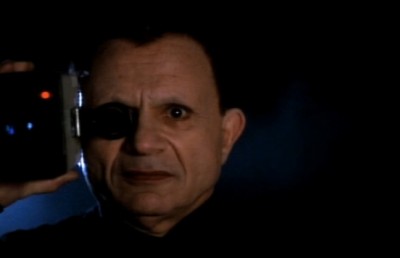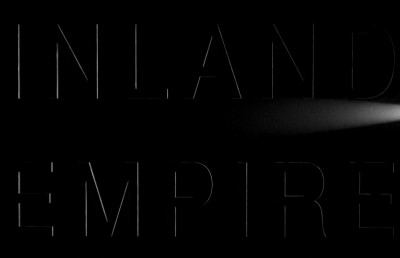Lynch: Meditation and Creativity

“Look at me, and tell me if you’ve known me before”: Meditation, creativity and some deeply, personally, real thoughts on INLAND EMPIRE
When the opportunity arose to attend a weekend retreat in Fairfield, Iowa, with David Lynch, the obvious answer was a resounding “Heck, yes!” The conference – to be held at the Maharishi University – was to cover meditation and the creative process, and included presentations by Donovan, and Jonathan Hagelin (of What the Bleep do We now fame). However, I was struck the weekend before by a spontaneous pneumothorax (I had to google it, too), which is a rather substantial amount of air escaping the lung, and lodging itself, painfully, in the chest between the lung and thorax. The one thing not recommended after having a tube surgically stuck into your chest is air travel, thus thwarting my Lynch weekend retreat into the cornfields of Iowa. But instead of sitting around feeling the effects of the prescription oxycodone, I thought I’d do something useful, and if not useful, at least time-consuming. Following, is a semi-dream-induced account of Lynch’s most recent work, my experience of meditation, and some other stuff. (Succinctly put, I’m going to take a few liberties here, if that’s alright).

Lynch’s work – painting, drawing, film, music, furniture… – excites me like nothing else. There are coincidental bells that ring in my consciousness, as a result of Lynch, trusting and adhering to things that ring in his consciousness, coupled with his energy, enthusiasm, and will to set those things into motion – to have those things realized in tangible, audible or visible form. The most publicized of recent developments in Lynch’s career – besides his self-release of INLAND EMPIRE – is his embrace of Transcendental Meditation, a technique popularized largely by the Beatles in the late-60’s (remember, the Beatles?), and taught by the Maharishi Mahesh Yogi. Actually, it is neither a recent nor new development at all; Lynch has been practicing TM for over 33 years, and the technique is known to have historical roots, which tie back approximately to the dawn of Buddhism. But I am not the expert on this.
I had long been interested in the technique, made the decision to become a meditator relatively lately, and can concur with Lynch’s assertions of increased mental clarity and focus, bliss in activity, limitless creativity and consciousness through transcending. According to the Maharishi’s teachings, we largely exist in three states of consciousness: waking, sleeping and dreaming. When one transcends, one enters the fourth state of consciousness – transcendental consciousness. This is much akin to that state we enter just before falling asleep, or just before waking. It is a state of alertness, but also one where we are still open to the depths of our consciousness seeping in through the interstitial cracks, or what Lynch has referred to as: “bubbling up to the surface”. There is something very real, very profound to be encountered in this fourth state, and (at least) three other states beyond.
Many people have issues with practices like this, citing a cult-like mentality, subscription to dogmatism, elitism, and monetary cost. And it is not my intention to write a promotional pamphlet for Transcendental Meditation. However, I do believe it to be true that TM largely informs the ‘look and feel’ (to whip out a phrase from ye olde Apple IIE days) of Lynch’s creative output. The human mind, and thus, human consciousness, does seem to have the at once macrobiotic and unbounded structure of a Lynch film, particularly INLAND EMPIRE. This film comes closer to approximating the human condition than any film, or for that matter, work of art in general.
Salvador Dali painted with this aim in mind. Chuck Palahniuk’s writings also spark many of those smoldering fires. Stan Brakhage wrote on trying to replicate closed-eye vision. But Lynch seems to actually get it right. This is why I think INLAND EMPIRE is not only Lynch’s most interesting work to date, but also perhaps one of the greatest films ever made. And this is not just the hyperbole of a 1930’s movie trailer talking. (Not the oxycodone, pie, or coffee either).
Let’s talk about architecture for a moment. Lynch has often used it as a staple of his films: the mythologized connection of his two Hollywood homes for Lost Highway; the construction of the façade for Eraserhead. The mind is like an infinite connection of hallways, or much like the wiring of a computer; rather one that is constantly under reconstruction, and in the midst of making new connections, forging previously unforeseen pathways. It is no secret that we become accustomed to certain patterns of thought, which we practice on a day-to-day, minute-by-minute basis. For example, if we think negatively, we tend to continue on a negative trajectory because it becomes hardwired into our programming. Eventually, it becomes more comfortable to think negatively, due to what I would deem as “mental inertia”. Once a body – in this case, a physical part of the whole body – is set in motion, it is likely that it will continue to stay in motion. But, with some effort – physically, emotionally, spiritually – it is possible to change, even reverse, that inertia to a positive trajectory.
The night before I began my meditation training, I had a dream. In it, I was on vacation with my family in Russia. We were touring a fantastic old castle, which was beyond scope in both age and magnitude. We were being ushered in a group through corridors, and into ever-increasingly larger rooms, more ornately decorated than each, which they preceded. We were led into one particularly expansive space, with deep, oiled wooden coffers in the ceiling, and ancient Mahogany-lined walls. A Kosak in traditional garb approached me, and in a thick Russian accent, asked: “Do you consider yourself a fearful person?” I replied: “Not particularly,” to which he responded by opening a grand set of Oak doors. He told me to wander around alone for about ten minutes, and to come back and relate what I had experienced. I entered through the doors, and stepped into a great salon, on a mezzanine. Both upward and downward seemed endless, and there was a staggered stage before me, made of coarse bluish marble, which vaguely resembled the scales of a fish. Water flowed down and through these scales, and into a vast pool below. I kept wandering, in awe of the sheer beauty and endlessness of this expansive space. Suddenly, I became aware of time, and thought that I must have been wandering for far longer than ten minutes. I panicked, and tried to find my way back to the salon with the mischievously impish Kosak. Then, I found myself at the entrance again. “Ok,” I thought. “I know my way back from here”. So I traced my original steps, however this time, I wasn’t walking, but gliding on thin air, as if roller-blading from room to room. This time around, it was far easier to move forward. In no time at all, I found my way back to that wood-saturated gorgeous space, and my family patiently waiting within.
I still don’t know what the meaning of this dream is, but I have no doubt that it is somehow connected to meditation, its anticipation, and the unboundedness of human consciousness. To me, INLAND EMPIRE is yet another in an infinite number of variations on this dream.
I had the pleasure of introducing another person to INLAND EMPIRE in New York – someone who had never seen a Lynch film before, much less being adequately psychically prepared for this new work. During the screening, I stole glances at her, sitting transfixed to my right as the film unfolded before us, on that chilly mid-February night at the IFC theatre. Never before had I seen that particular look of wonder in another human being’s eyes. And at the end (for which, if you have seen the film, you will now know why), she clutched my arm and buried her face into my shoulder – a guiltily satisfying response, I must admit.
I have subsequently seen the film thrice more (although under less-than-ideal circumstances at Cinéma du Parc), and have been overjoyed by hearing other patrons talk about their unique interpretations afterwards. At a 1996 showing of his paintings and drawings at a Californian gallery, Lynch was quoted as saying: “A lot of different people do a lot of different things. And these are some of the different things that I do.” Indeed, Lynch does a lot of different things, differently. The thing about Lynch’s work, and largely because he won’t explain anything, is that it invites interpretation, allowing the receiver to invent or conjure the most outlandish of explanations without any academic consequence. Indeed, as Wimsatt and Beardsley infamously wrote: Meaning does not necessarily reside with the Oracle. It is honorable to double-check, but beyond that, everything becomes fair game.
Enthymemically, if Lynch won’t talk about interpretation, there must be an interpretation there, and a darned profound one. I have even made the odd albeit ironic comment: “I liked the part where they stole a car, went to the beach, fell in love and live happily ever after.” I’m still not sure if I have adequately remade the film in my memory. This is often where Lynch’s work achieves its most salient characteristics – after one has had a few weeks for the remote memory to ferment in its dark and organic recesses.
Mr. Lynch, a short time ago, had a retrospective of his paintings and drawings at the Fondation Cartier pour l’art contemporain in Paris, for which there is a beautiful companion publication entitled: THE AIR IS ON FIRE. In it, the works are deliberately left undated, as if to echo Grace Zabriskie’s dialogue in INLAND EMPIRE: (not a direct quote, but to the effect of), “I can’t remember if it is today, or two days from now” – not to mention Laura Dern’s reprise: “We were filming the scene yesterday, but I know it was tomorrow.” Still later, Dern tells the derelict therapist at the top of an exhausting flight of stairs, how the order of her life’s events does not follow chronology in her memory. Nor does it matter in life as in film as in art. In Lynch’s work, the chain of events is always tertiary to their aesthetic, their happenstance.
Because Lynch refuses to talk about the meaning of his work, and in that spirit, I would like also to not discuss the ‘meaning’ of INLAND EMPIRE in this brief re-view. I’d rather prefer to part with another anecdote.
Recently, I gave a presentation on Lynch in an undergraduate class on independent film directors. In the course of my talk, I offered a chink of insight in the form of metaphor, one which occurs early into TWIN PEAKS: FIRE WALK WITH ME. It is the scene where Lynch-as-Cole is introducing Sam Stanley and Chet Desmond to Lil. As you will no doubt recall, Lil is a form of code used for F.B.I. briefings to ensure and enforce secrecy and mutually exclusive understanding. My argument was that Lil is a sign of Lynch’s cinema as a body, as a whole, as an entirety. There are certain things placed strategically: the tailored dress as a code for drugs, the walking-in-place as a code for a ‘lot of leg-work involved.’ My argument, which seems to make all the more sense in retrospect, is that this is how Lynch artistically operates. Of course, it is also of doubtless significance in this film that it is Lynch himself showing Lil to the agents, to the audience. There are certain things imbedded into his films, his art, which signify other things. Fire = X; Curtains = Y et al. If one is to look, really look, one will see – easily. However, the magic – in both Lil’s performance, as well as that of Lynch’s oeuvre – is the ‘blue rose.’ And neither I, nor anyone, not Lynch himself can tell you about that.
Are you looking for footnotes? To quote Irene from Hap’s diner, “…We don’t have any”.













